





Water gardeners often love their pond plants and animal inhabitants equally. Hobby koi keepers and water gardeners are interested in anything that adds color and life to their ponds. If you've had a hard time understanding koi varieties and jargon, maybe this basic guide can be of help.
Understanding koi varieties can sometimes be difficult. There are so many different variables of color and markings, and on top of that these variables can be combined to create distinct koi varieties. For the purposes of this article, we will treat the koi types in their most basic form for ease of understanding.
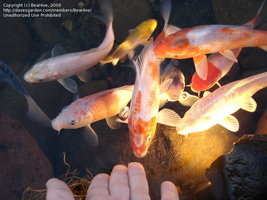 DG member BeaHive feeding her koi
DG member BeaHive feeding her koi
Koi is the shortened version of nishikigoi, the Japanese word for Cyprinus carpio which is bred and kept in water gardens around the world. The easiest way to identify a koi is by looking for 2 sets of barbels near the koi's mouth which look like whiskers. You can also identify the variety of koi by the color formation.
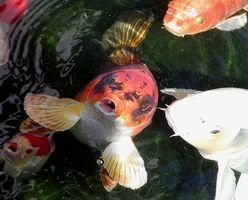
Main koi color and scale variations
When you read about koi, their colors will be identified by their Japanese names. It can be very confusing unless you know what each word means and how it is used. As body color or color shapes, the four main colors are referred to as the following:
HiHee RedKiKeeYellow SumiSOO-mee Black ShiroSHE-roWhite
Koi Varieties
Kohaku
koh-HAW-koo
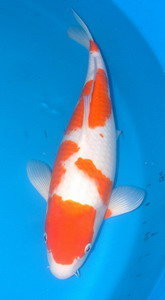 Kohaku are arguably the most common and recognizable of all koi types. Their markings are only hi (red) on shiro (white) which can come in a variety of different formations and shapes.
Kohaku are arguably the most common and recognizable of all koi types. Their markings are only hi (red) on shiro (white) which can come in a variety of different formations and shapes. Ogon
O-gahn
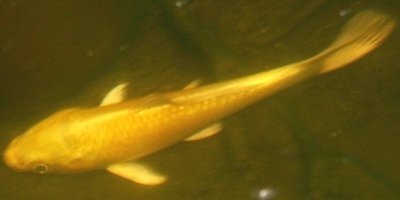
Ogon refers to a solid color koi that can be regular or metallic. The most popular ogon varieties are platinum and yellow (Yamabuki).
Tancho
TAHN-cho
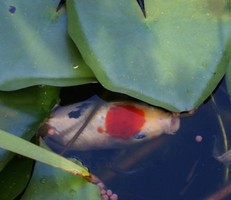 Tancho koi have a round hi (red) marking well-placed on their head. This is a significant marking in Japanese koi breeding because of its resemblance to the national flag of Japan. Tancho markings can be combined with other markings such as Bekko.
Tancho koi have a round hi (red) marking well-placed on their head. This is a significant marking in Japanese koi breeding because of its resemblance to the national flag of Japan. Tancho markings can be combined with other markings such as Bekko.Asagi
ah-SAH-gee
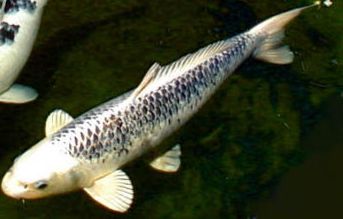 Asagi koi look like they have a net or pinecone as scales. Their bluish scales are surrounded by white and the fins should be hi (red).
Asagi koi look like they have a net or pinecone as scales. Their bluish scales are surrounded by white and the fins should be hi (red). Shusui
SHOE-swee
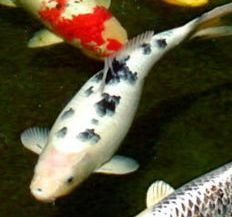 Shusui koi are distinguishable by their blue-tinted doitsu scales which look like a zipper down the back. The side markings can be hi(red), ki (yellow), or shiro (white). Shusui is the closely related, scaless version of Asagi.
Shusui koi are distinguishable by their blue-tinted doitsu scales which look like a zipper down the back. The side markings can be hi(red), ki (yellow), or shiro (white). Shusui is the closely related, scaless version of Asagi. Showa
SHOW-a
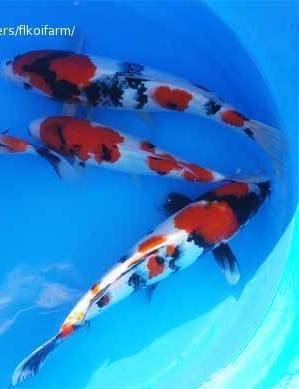 Showa is a black koi with hi (red) and shiro (white) markings with crisp edges between the three colors. Sanke in another type of koi that is easy to get confused with Showa. Sanke are white fish with red and black markings.
Showa is a black koi with hi (red) and shiro (white) markings with crisp edges between the three colors. Sanke in another type of koi that is easy to get confused with Showa. Sanke are white fish with red and black markings.Bekko
BAY-co
 Bekko koi have black markings on top of another single color such as shiro, ki, and hi. Bekko should not be confused with Utsuri, which are koi with black bodies with colored markings on top. It can be hard to differentiate which color is the body color and which color marking is on top, though with practice the distinction can become more apparent.
Bekko koi have black markings on top of another single color such as shiro, ki, and hi. Bekko should not be confused with Utsuri, which are koi with black bodies with colored markings on top. It can be hard to differentiate which color is the body color and which color marking is on top, though with practice the distinction can become more apparent. Gin Rin (Geen-Reen)
Gin Rin refers to any koi with a shimmery appearance to their scales; stemming from Gin meaning silver or metallic and Rin meaning shiny scales. Any koi variety can have Gin Rin scales, such as the Gin Rin Kohaku below.
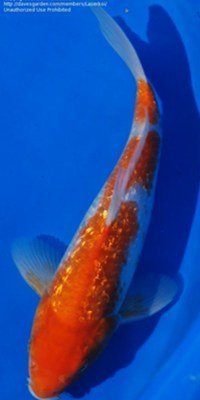 Gin Rin Kohaku
Gin Rin Kohaku
Doitsu (DOYT-zoo)
Doitsu refers to koi with large scales down their back and no other scales on their body. This feature was bred into Japanese koi from German carp. Any type of koi can have Doitsu scales, such as a Doitsu Kohaku. In the photo below, you can see the large "zipper" scales down the koi's back and the fish is otherwise scale-less.
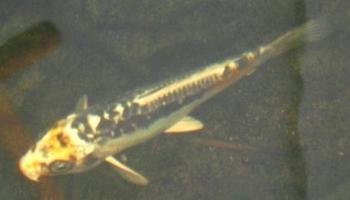 Doitsu Koi
Doitsu Koi
Long Fin Koi
Long fin koi, also known as butterfly koi and formerly dragon carp, are an interesting addition to koi breeding and hobby keeping. Their long flowing fins are striking in the water garden and add a whole new dimension to hobby koi keeping. With recent advances in their color breeding, long fin koi are available in a variety of color types such as Kohaku, Showa, and Bekko. If you want to read more about how long fin koi came into popularity this link has an interesting firsthand breeder's account.
For an excellent illustration on different koi types, check this link.
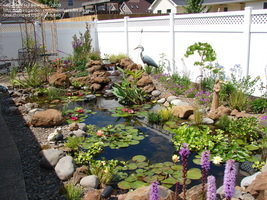 DG member BeaHive's water garden oasis
DG member BeaHive's water garden oasis
Can you pick out all the koi varieties in this video?
Koi typing has a massive amount of gray area especially in the hobby portion of the field. Sometimes it is nearly impossible to identify a non-show quality fish, which most water gardeners have, in a specific category. Of course that doesn't make these fish any less valuable or beautiful in the home water garden. Mutts are just as beautiful to water gardeners!
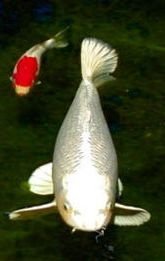 Platinum Ogon Koi
Platinum Ogon Koi
So long as you enjoy your koi, it doesn't matter what they look like or which category they fall under. Enjoy your koi and your water garden this season!
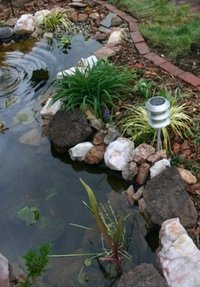
::::::
Photo credits:
Photo of hand fed koi and BeaHive's water garden: Bernadette Ducasse
Gin Rin Kohaku and Showa: DG member and koi breeder Laserkoi
Tancho: DG member themir
Kohaku: Ian John of backyardpuddle.com
Bekko, Asagi, Shusui, Hi Bekko, and Platinum Ogon: Free use images from Wikipedia Commons
All other images belong to the author
Sources:
http://homepage.ntlworld.com/a.antonio/antoniokoi_007.htm
http://www.vskc.net/koi.htm
http://www.youtube.com/watch?v=Ddeo1ckdS6o
http://inlandkoi.com/
www.backyardpuddle.com
Copyright © www.100flowers.win Botanic Garden All Rights Reserved